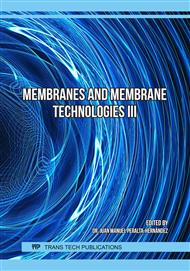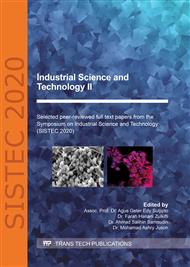[1]
S. Jahangiri, I. Aravi, L. Şanlı, Y. Menceloglu, and E. Ozden-Yenigun, Fabrication and optimization of proton conductive polybenzimidazole electrospun nanofiber membranes, Polymers for Advanced Technologies 29 (2017) 594-602.
DOI: 10.1002/pat.4169
Google Scholar
[2]
R. Kunwar, M. Harilal, S. Krishnan, B. Pal, I.I. Misnon, C.R. Mariappan, F. Ezema, H.I. Elim, C-C. Yang, R. Jose, Pseudocapacitive Charge Storage in Thin Nanobelts, Advanced Fiber Materials 1 (2019) 205-213.
DOI: 10.1007/s42765-019-00015-w
Google Scholar
[3]
R. Jose, S.G. Krishnan, B. Vidyadharan, I.I. Misnon, M. Harilal, R.A. Aziz, J. Ismail, M.M. Yusoff, Supercapacitor Electrodes Delivering High Energy and Power Densities, Materials Today: Proceedings 3 (2016) S48-56.
DOI: 10.1016/j.matpr.2016.01.007
Google Scholar
[4]
R. Stoddard, and X. Chen, Electrospinning of ultra-thin nanofibers achieved through comprehensive statistical study, Materials Research Express (2016) 055022.
DOI: 10.1088/2053-1591/3/5/055022
Google Scholar
[5]
S. Gee, B. Johnson, and A.L. Smith, Optimizing electrospinning parameters for piezoelectric PVDF nanofiber membranes, Journal of Membrane Science 563 (2018) 804-812.
DOI: 10.1016/j.memsci.2018.06.050
Google Scholar
[6]
S. Anandhan, K. Ponprapakaran, T. Senthil, and G. George, Parametric study of Manufacturing Ultrafine Polybenzimidazole Fibers by Electrospinning, International Journal of Plastics Technology 16 (2012) 101-116.
DOI: 10.1007/s12588-012-9036-2
Google Scholar
[7]
S.-Y. Kim, S. Kim, and M. J. Park, Enhanced proton transport in nanostructured polymer electrolyte/ionic liquid membranes under water-free conditions, Nature communications 1 (2010) 88.
DOI: 10.1038/ncomms1086
Google Scholar
[8]
H. Penchev, F. Ublekov, D. Budurova, and V. Sinigersky, Novel Electrospun Polybenzimidazole Fibers and Yarns from Ethanol/Potassium Hydroxide Solution, Materials Letters 187 (2017) 89-93.
DOI: 10.1016/j.matlet.2016.10.063
Google Scholar
[9]
M. Forouharshad, O. Saligheh, R. Arasteh, and R. Farsani, Manufacture and Characterization of Poly (butylene terephthalate) Nanofibers by Electrospinning, Journal of Macromolecular Science, Part B: Physics 49 (2010) 833-842.
DOI: 10.1080/00222341003609377
Google Scholar
[10]
D. G. Yu, C. Branford-White, K. White, N. P. Chatterton, L. M. Zhu, L. Y. Huang, and B. Wang, A modified coaxial electrospinning for preparing fibers from a high concentration polymer solution, Express Polymer Letters 5 (2011) 732-741.
DOI: 10.3144/expresspolymlett.2011.71
Google Scholar
[11]
F. Hakkak, and M. Rafizadeh, Optimization of Electrospun Polyacrylonitrile/Poly(Vinylidene Fluoride) Nanofiber Diameter Using the Response Surface Method, Journal of Macromolecular Science, Part B: Physics 52 (2013) 1250–1264.
DOI: 10.1080/00222348.2013.763569
Google Scholar
[12]
Y. Xu, L. Zou, H. Lu, and T. Kang, Effect of different solvent systems on PHBV/PEO electrospun fibers, RSC Adv. 7 (2017) 4000-4010.
DOI: 10.1039/c6ra26783a
Google Scholar
[13]
E. Kiliç, A. Yakar, and N. Pekel Bayramgil, Preparation of electrospun polyurethane nanofiber mats for the release of doxorubicine, Journal of Materials Science: Materials in Medicine 29 (2018).
DOI: 10.1007/s10856-017-6013-5
Google Scholar
[14]
P. Szewczyk, D. Ura, S. Metwally, J. Knapczyk-Korczak, M. Gajek, M., Marzec, A. Bernasik, and U. Stachewicz, Roughness and Fiber Fraction Dominated Wetting of Electrospun Fiber-Based Porous Meshes, Polymers 11 (2018) 34.
DOI: 10.3390/polym11010034
Google Scholar



